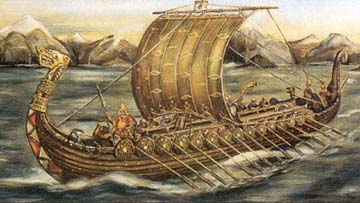Norse and Icelandic Sagas
Sagas are long narratives that appeared
in Norway, Iceland and other parts of Scandinavia during the middle ages.
These stories were passed down orally for many generations prior to being
transcribed in the 13th century. Many sagas were written in a objective
style that led some early historians to believe they were historically
accurate. When later research revealed that the sagas made use fictitious
situations vaguely grounded on some remote historical reality, historians
tended to reject them completely.
While the value of the sagas as accurate
history must certainly be questioned, it should also be remembered that
the names and spirit of the history represents the knowledge of a person
many centuries closer to the truth than we are to-day.
A 14th century manuscript of Snorri Sturluson's
Prose
Edda
 |
This book of ancient Scandinavian literature was compiled
by Snorri Sturluson about 1222.
Other sagas include the Elder Edda or Codex
Regius and the Heimskringla which chronicles the
Kings of Norway. The Eddas are invaluable sources on pre-Christian Scandinavian
culture. Equally important is the Saga of Erik the Red
and the Greenlanders' Saga.
One of the best known sagas in Grettis,
which follows the adventures of Grettir, an Icelandic outlaw who battles
a monster called Glamr, not unlike the Anglo-Saxon story of Beowulf. |
Generation One
Radbard, King in Russia
In the early middle ages, the land
known to-day as Russia was composed of a number of small city states, and it
is to be imagined that Radbard established himself as "king" of one of
these cities. However, historical evidence indicates that Scandinavians
such as Radbard journeyed to Russia circa 850, and most certainly no earlier
that 800. It is difficult to reconcile this fact with the concept
that Radbard's great X2 grandson is said to be the historical figure Ivar
"the Boneless" Ragnarsson, who became King of Dublin in 856. See
Generation
Four below for mention of Ivar "the Boneless" Ragnarsson.
However, according to legend, Radbard had a son:
 Generation
Two
Generation
Two
Randver Radbardsson who had
a son:
Generation Three
Sigurd Ring who had a son:
Generation Four
Ragnar Lodbrock, who is mentioned
in Snorre's Sturluson's Saga "the Icelandic Landnamobok" or "Book of Settlement".
However, most historians regard much of the genealogy at this point to
be purely legendary, or even mythical.
Ragnar married to Aslaug Sigurdsdottir, daughter of Sigurd
Wolsung and they had the following children:
-
Ivar "the Boneless" Ragnarsson, who became King of Dublin
in 856, conquered York 866/7, slayed St. Edmund of East Anglia 869 and
died in 873.
| Some sources attempt to explain Ivar's unusual name "the Boneless" as an
indication that he suffered since birth from a genetic disorder that resulted in
either very soft gristle-like bones or very brittle, easily broken bones that
leave one unable to walk. This idea is thought to have come from the Old Norse
"inn beinlaussi" which means "without bones" or even "without legs." This may
have been a mishearing of "inn barnlausi" which means "without children" - - -
Ivar didn't have any children. Alternatively, perhaps the Latin "exosus" or
"hateful" was misheard as "exos" or "boneless." Regardless, it is entirely
unlikely that in the brutally practical world of 9th century Scandinavia that a
handicapped person would have survived, let alone led Viking armies into
battle.
. . . Justin Pollard: Alfred the Great, John Murray
Publishers, London, 2005, pages 89 & 90.
With regard to Ivar's position as "King of Dublin", the World Book Millenium 2000 Deluxe Edition,
© 1999 World Book Inc., © IBM Corp. tells us: "Vikings
established Dublin in the mid-800's, though a small settlement had previously
been on the site. The Viking town was named Dublin, from the Irish
words dubh, meaning black; and linn, meaning pool. The name may refer
to a pool of dark water in a branch of the River Liffey. The branch
is now filled in by land." |
-
Halfdan "White Shirt" Ragnarsson, who became King of Dublin
in 875 and died in 877.
-
Sigurd "Snake-in-Eye" Ragnarson
-
Bjorn "Ironside" Ragnarson, who was a semi-legendary King of Sweden.
-
Ragnhildir Ragnardottir
-
Alof Ragnarsdottir
-
Ubbe Ragnarsson, who may have been slain in Devon during
King Alfred's second war
Generation Five
Sigurd "Snake-in-Eye" Ragnarson
who had the following children:
-
Tora Sigurdsdottir
-
Aslaug Sigurdsdottir
-
Horda-Knut Sigurdsson, who had a son:
-
Gorm "the old" of Jutland, King of Denmark, born about 840
Generation Six
Tora Sigurdsdottir who married
Ragnvald Gudrodssoof Agder and they had a daughter:
Generation Seven
Ascrida Ragnvaldsdottir who
married Eystein "the Noisy" Glumra, Jarl of the Uplanders
For the continuation of this line, please click on
Eystein
"the Noisy" Glumra.
The information on this page is drawn from the following
sources:
-
World Book Millenium 2000 Deluxe Edition, ©
1999 World Book Inc., © IBM Corp.
-
Norman F. Cantor (ed.): The Encyclopędia of the
Middle Ages, New York, 1999
-
Barnes and Hudson: The History Atlas of Europe,
New York, 1998
-
The Book of History (18 Volumes), London, 1914
-
Brian Tompsett, Royal Genealogical Data,
http://www3.dcs.hull.ac.uk/genealogy/royal/
Click to return to the top
of this page.
Please visit the Sewell
Genealogy Site Map for other pages.

 Generation
Two
Generation
Two
